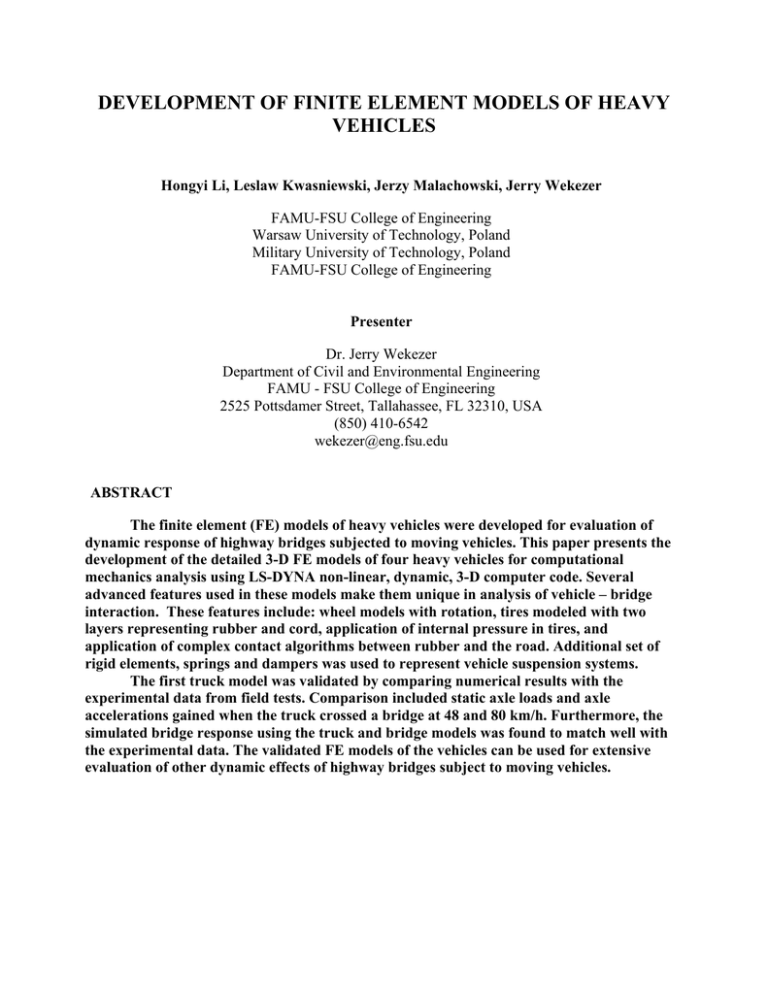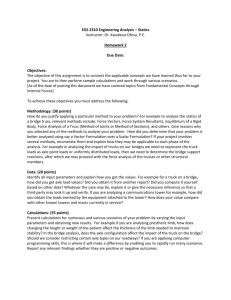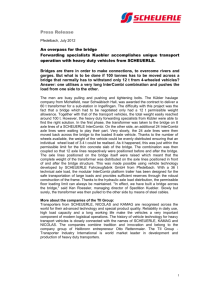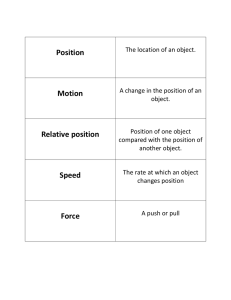DEVELOPMENT OF FINITE ELEMENT MODELS OF HEAVY VEHICLES
advertisement

DEVELOPMENT OF FINITE ELEMENT MODELS OF HEAVY VEHICLES Hongyi Li, Leslaw Kwasniewski, Jerzy Malachowski, Jerry Wekezer FAMU-FSU College of Engineering Warsaw University of Technology, Poland Military University of Technology, Poland FAMU-FSU College of Engineering Presenter Dr. Jerry Wekezer Department of Civil and Environmental Engineering FAMU - FSU College of Engineering 2525 Pottsdamer Street, Tallahassee, FL 32310, USA (850) 410-6542 wekezer@eng.fsu.edu ABSTRACT The finite element (FE) models of heavy vehicles were developed for evaluation of dynamic response of highway bridges subjected to moving vehicles. This paper presents the development of the detailed 3-D FE models of four heavy vehicles for computational mechanics analysis using LS-DYNA non-linear, dynamic, 3-D computer code. Several advanced features used in these models make them unique in analysis of vehicle – bridge interaction. These features include: wheel models with rotation, tires modeled with two layers representing rubber and cord, application of internal pressure in tires, and application of complex contact algorithms between rubber and the road. Additional set of rigid elements, springs and dampers was used to represent vehicle suspension systems. The first truck model was validated by comparing numerical results with the experimental data from field tests. Comparison included static axle loads and axle accelerations gained when the truck crossed a bridge at 48 and 80 km/h. Furthermore, the simulated bridge response using the truck and bridge models was found to match well with the experimental data. The validated FE models of the vehicles can be used for extensive evaluation of other dynamic effects of highway bridges subject to moving vehicles. DEVELOPMENT OF FINITE ELEMENT MODELS OF HEAVY VEHICLES Hongyi Li, Leslaw Kwasniewski, Jerzy Malachowski, Jerry Wekezer FAMU-FSU College of Engineering Warsaw University of Technology, Poland Military University of Technology, Poland FAMU-FSU College of Engineering 1 INTRODUCTION The Florida Department of Transportation (FDOT) is involved every day in processing overload permit applications from trucking companies which move heavy construction equipment and other overweight vehicles (e.g. cranes) across the state. Knowledge of the actual dynamic bridge –vehicle interaction assists FDOT engineers in determination of the load effect and in condition assessment of existing bridges. It helps the Department make management decisions regarding the overload permits and therefore has important economical and safety implications. FE analysis was selected as a research approach to study the dynamic response of highway bridges subjected to moving vehicles. Variety of contact algorithms implemented in LSDYNA makes the code suitable to investigate the vehicle-bridge interaction using more realistic vehicle models instead of the simplified point loads. Therefore, development of reliable and realistic vehicle models was an important task in this project. Four vehicle models were developed with the LS-DYNA nonlinear, dynamic, 3-D explicit computer code. The first model was developed to represent a tractor-trailer which was used by the FDOT structures lab to conduct bridge tests. The other three models were developed for cranes, which represented the overweight class of the vehicles on Florida highways and which were the major concern of the FDOT Maintenance Office. The tractor-trailer model was validated by comparing the simulation results with the data from the field tests which were conducted on a selected highway bridge in northern Florida. 2 DEVELOPMENT OF THE TRUCK MODEL As shown in Figure 1, the FDOT testing truck is a specially designed tractor-trailer combination with a self-contained hydraulic crane which can load concrete blocks on the truck. Twelve concrete blocks were added to the truck so that the total weight was 319 kN, close to the 325 kN required for the AASHTO HS 20-44 truck. The front, drive, and rear axle loads were 50 kN (11.3 kip), 100 kN (22.5 kip) and 169 kN (38.0 kip) respectively. Figure 1. The FDOT testing truck. The models of the tractor and the trailer were developed separately. An AutoCAD file describing the geometry of the tractor was used for the tractor model while the trailer model was developed from technical drawings and in-situ measurements. After the tractor and trailer were assembled together, all FE meshes were verified for inconsistencies and refined to improve the mesh quality (Chenga, 2001). Decisions regarding element formulations, material models, material characteristics, contact algorithms, multiple point constraints (MPCs) and connections, loading and boundary conditions, solution parameters and others were made to complete the model. Special attention was paid to the suspension system and the wheel models since they were critical for the dynamic interaction with the bridge. The entire truck model consists of 12,934 elements and 9 material types including springs and dampers for suspension. Constitutive material models and mechanical properties used for the wheel FE model have a significant effect on the dynamic reactions applied to the bridge deck. Major wheel components include tire, rim and drum as illustrated in Figure 2. + drum + rim = tire complete model of wheel Figure 2. Development process of FE model for wheel. The tire and rim were modeled using shell elements while the drum was modeled with solid elements (Kwasniewski, 2002). Two layers of shell elements were generated for tire at the same position with different materials. One layer was made of elastic material with average properties for rubber. The other material represented the tire fabric. It was modeled with thin shell elements with tensile resistance only. Linear elastic model with properties for steel was used for the rim and drum of the wheel. Internal pressure was appropriately represented by applying LS- DYNA AIRBAG option to the wheel model (LS-DYNA, 1998). The magnitude of pressure was read from the actual truck tires using a pressure gauge. Due to the complex and irregular shape of the suspension system, it was represented by a series of 1-D structural elements such as beams, rods, springs, dampers, as well as a variety of MPCs (Kwasniewski, 2002). Figure 3 shows the simplified middle suspension system. Spring stiffness and damping properties were established based on the acceleration readings registered during the field tests by four transducers located on the vehicle. Figure 3. FE model of the middle suspension system. Extreme deterioration of road surface, such as the threshold before the bridge slab, or a piece of wooden board dropped across the bridge slab was found to be important factors for the entire vehicle-bridge interaction. Introduction of wheel rotation was necessary to capture physics of a wheel rolling over the board or a threshold between the end of the road and the beginning of the bridge deck. A cycloid representing a trajectory of a selected node on the front wheel is depicted in Figure 4. Figure 4. The cycloidal trajectory of a node selected on the front tire. Summary of parts, materials and elements used for the entire truck model is provided in Table 1. Table 1. Summary of the FE model of the FDOT truck. Entity Number Number of parts (LS-DYNA) 157 Number of material models 9 Number of MPCs 103 Number of nodes 6,312 Number of solid elements 438 Number of shell elements 11,891 Number of beam elements 605 Total number of elements 12,934 3 VALIDATION OF THE TRUCK MODEL The first element of the validation process was checking the mass distribution and axle loads. To calculate the static axle loads, ten nodes on the five truck axels were selected to be constrained in the vertical direction while gravity was applied to the truck. The rapid application of gravity caused transient vibrations which were quickly damped by using a high global damping factor. Each axle load was calculated using the node reactions. The calculated axle loads were compared with the measured ones. If big discrepancy was observed, the FE model had to be refined until sufficient accuracy was achieved. Figure 5 shows the time history of the axle loads for the truck loaded with 12 concrete blocks while Table 2 presents the comparison of the axle loads from the FE model and from the field measurement. Iterative mass distribution process was continued until maximum discrepancies were smaller than 2%. Axle 5 Axle 4 1371 mm 54 in Axle 3 6419 mm 252.7 in 1410 mm 55.5 in Axle 2 Axle 1 4730 mm 186.2 in 200 front axle 180 drive axle rear axle 160 Axle force (kN) 140 120 100 80 60 40 20 0 0 0.2 0.4 0.6 0.8 1 1.2 Time (s) Figure 5. Time history of axle loads for the truck loaded with 12 blocks. Table 2. Comparison of the axle loads from FE analysis and measurement. Measured Difference Axle force FE model [kN] by FDOT Error [%] [kN] [kN] Front 1st 51.53 51.53 50.62 0.91 1.80 % 2nd 45.14 Drive 101.30 100.44 0.86 0.86 % 3rd 56.16 4th 94.19 Rear 170.60 169.88 0.72 0.42 % 5th 76.41 Total 323.43 323.43 320.94 2.49 0.78 % The FDOT truck instrumented with four accelerometers was used for several dynamic bridge tests. Two accelerometers were attached on the tractor with one at the middle of rear axle and the other on the transverse beam as shown in Figure 6. The other two accelerometers were fastened to the trailer, one to the rear axle and one to the cross member on the frame. Accelerometers #15 #16 Figure 6. Position of accelerometers on the tractor. The vertical accelerations were registered in a sequence of field experiments when the truck passed through a small highway bridge in northwestern part of Florida. These experiments were also simulated using the LS-DYNA computer code and the FE models of the truck and the bridge developed for this research. Figure 7 and Figure 8 show comparison of the recorded and calculated acceleration at the rear axle of the tractor with speed of 48 km/h and 80 km/h. A good correlation between calculated and experimental data provides an evidence of quality, reliable models developed for this research. 4.00E+04 Experiment FE analysis 3.00E+04 Acceleration (mm/s 2 ) 2.00E+04 1.00E+04 0.00E+00 -1.00E+04 -2.00E+04 -3.00E+04 -4.00E+04 1 1.5 2 2.5 3 3.5 4 Time (s) Figure 7. Comparison of vertical acceleration histories for the rear axle of the tractor at 48 km/h. 4.00E+04 Experiment FE analysis 3.00E+04 Acceleration (mm/s 2 ) 2.00E+04 1.00E+04 0.00E+00 -1.00E+04 -2.00E+04 -3.00E+04 -4.00E+04 1 1.5 2 2.5 3 3.5 4 Time (s) Figure 8. Comparison of vertical acceleration histories for the rear axle of the tractor at 80 km/h. 4 DEVELOPMENT OF CRANE MODELS Overweight vehicles as cranes are the major concern of the FDOT when processing overload permit applications from trucking companies. An LTM 1080 crane, recommended by the Florida Crane Owners Council (FCOC), was selected for FE model development. Since the suspension system and wheels were the most important components for the bridge-vehicle interaction, they were developed using the same technique which was used in the FDOT truck model. However, the other components were simply represented by shell and solid elements under the condition that the axle loads should be close to the actual ones. The crane and its model are depicted in Figure 9. Figure 9. The LTM 1080 crane and its FE model. Table 3. Comparison of the axle loads for LTM 1080. Provided by Difference FE model manufacturer Error [%] Axle [kN] [kN] [kN] 1-st 101.71 100.84 0.87 0.86 2-nd 101.68 100.55 1.13 1.1 3-rd 97.94 99.28 -1.34 -1.3 4-th 97.91 98.49 -0.58 -0.59 399.24 399.16 0.08 0.02 Total weight Validated suspension and wheel models from the FDOT truck model were used for the crane models. In addition, an overall mass of the crane was distributed in the model with maximum estimated error of 1.3%. The results of that comparison are presented in Table 3. Two other crane models, with additional loadings of 22.3 kN and 44.5 kN respectively, were developed based on the first crane model. The additional loads were evenly applied to the two rear axles to serve as FE models of the heaviest cranes on Florida highways. 5 DYNAMIC RESPONSE OF BRIDGE SUBJECTED TO MOVING VEHICLES With the vehicle models and bridge models (development of bridge models is not discussed in this paper), the dynamic response of highway bridges subjected to heavy vehicles could be thoroughly investigated (Marzougui, 2001). As an example, Figure 10 shows the time history of the deflection at the middle of the bridge span when the FDOT truck passed over the bridge at 48 km/h. Computational models of the truck and the bridge developed exhibit an excellent agreement of calculated displacements with the experimental data. The good correlation of the FE analysis and experiment data for the bridge response, from the other hand, was used as a convincing validation tool of the bridge and truck models. 6 CONCLUSION Four vehicle models were developed for investigation of the vehicle-bridge interaction. Some advanced features were implemented in the truck models. These features included three dimensional models of pneumatic, rotating wheels, tires modeled with two layers representing rubber and cord, application of internal pressure in tires, and usage of complex contact algorithms. Good correlations between the FE analysis and experimental data indicate the vehicle models have good potential for representation of the vertical movements and enable for extensive study of vehicle-bridge interaction. 0.5 Displacement (mm) 0 -0.5 -1 Experim ent -1.5 FE Sim ulation -2 -2.5 0 1 2 3 4 5 Time (s) Figure 10. Comparison of experimental recordings and numerical results for displacement at the middle of the bridge span. ACKNOWLEDGEMENT The study reported in this paper was supported by a grant from the Florida Department of Transportation titled: “Analytical and Experimental Evaluation of Existing Florida DOT Bridges”, contract No. BD 493. Opinions and views expressed in this paper are those of the authors and not necessarily those of the sponsoring Agency. The authors would like to express their appreciation for this generous support. Thanks are due to Jean Ducher, the Project Manager and to Marcus Ansley, Director of the Structures Laboratory of the FDOT for their commitments, advice, and technical support. REFERENCES Chenga, Z.Q., Thackera, J.G., Pilkeya, W.D., Hollowellb, W.T., Reagana, S.W. and Sieveka, E.M. (2001). “Experiences in reverse-engineering of a finite element automobile crash model,” Finite Element Analysis 37:843–860. Kwasniewski, L., Li, H. and Wekezer, J. (2002). “Reverse engineering of a transit bus for FE crashworthiness assessment,” Proc. 7th International Symposium on Heavy Vehicle Weights & Dimensions, 2002:505-511. Kwasniewski, L., Wekezer, J. and Li, H. (2002). “Development of finite element models for Ford Eldorado transit bus,” Proc. 10th Polish-Ukrainian Transactions -Theoretical Foundations of Civil Engineering, 2002:255-267. LS-DYNA Theoretical Manual (1998). Livermore Software Technology Corporation, Livermore, California. Marzougui D., Jin S., Livingston R. A. (2001). “Development of an LS-DYNA nonlinear finite element model for use in damage detection and health monitoring of highway bridges,” Proc. Health Monitoring and Management of Civil Infrastructural Systems, SPIE, Vol. 4337, 2001:432440.




